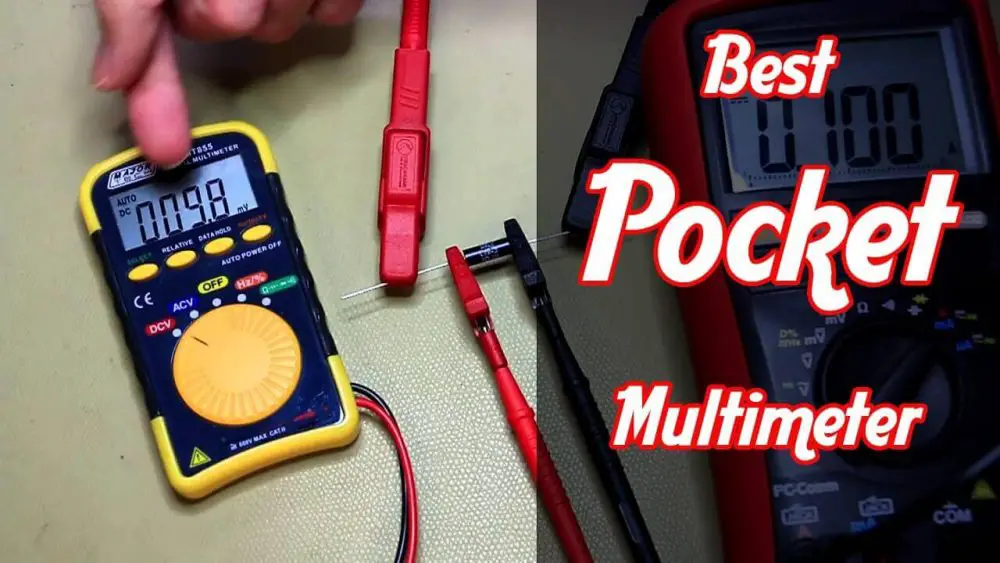How to test the battery with a multimeter?
One of the most basic household purposes to use a multimeter is battery testing. The simplest way to check a (AA) battery, is generally used in remote control of the TV. To check whether it is in good condition or not, connect it to a multimeter’s test probes and measure its voltage or amperage. If you have wondered how to test a battery with a multimeter, this guide will walk you through it.
We will use a pocket digital multimeter because we need a simple tool to test and a 9-volt battery for this guide.
For more knowledge about measuring other measures such as resistance or capacitance, check out our other articles.

Table of Contents
How to Test a Battery:
The fundamental purpose is to check if a battery is capable of providing enough amperage to a load.
In this case, We will consider the load as a TV remote control (RC). For a nine-volt battery, we will test both the voltage as well as the current.
How to Check Battery Voltage Using a Multimeter?
We are setting up a multimeter, along with the battery, to test. We will use a 9-volt transistor battery for this guide.
Step 1:
First, we will measure the voltage of the battery. Second, we will measure the current. To do this, Move the selector dial to select D/C voltage measurement. Since the battery generates D/C power, therefore, we will measure D/C voltage.
Step 2:
We previously knew that the battery’s voltage is 9 Volt maximum so we will point the dial to a higher range of 20 Volts.
Step 3:
Connect the test probes – black with negative, red with positive – to the battery and check the display.
Step 4:
The display should read a value that is just short of 9Volt. Because this battery has been in use for some time, it shows a reading of 8.74Volts, which is still sufficient to supply current to the load.
Step 5:
For a different (drained) battery, the reading looks like this
In most cases, this voltage measurement of a battery is enough to understand that it’s working perfectly.
However, to assure that it can supply enough current to a load; therefore, we also measure the ampere in milliampere-hour (mAh).
How to Measure Battery Amps With A Multimeter?
Step 1:
Select the D/C current function using the dial and keep it at 200mA since the battery’s amperage will be around 100mAh.
Step 2:
Connect the test probes similarly, before as we did for voltage measurement and check the display.
It could fluctuate around 98.3, which indicates that the amperage is 100mA – enough to run the small PCB of the TV remote control.
It would be unmistakable that testing a battery using a multimeter is one of its most accessible applications.
So, whenever your TV or any functioning remote control starts acting funny, you can immediately take out your multimeter and start getting some answers.
Indeed if the battery shows a good reading, there can still be an issue while connected to a load.
There are some multimeters open in the market that resemble a load to test the battery. These multimeters can be a great addition to your toolbox.
While operating, if a battery has a voltage level that is half of its initial rating, it might be a good idea to get a new one; why? Because batteries drain out faster once they reach half-life.
You may also use a simple voltmeter or an analog multimeter to test batteries. These multimeters will give you an accurate, direct reading on the scale instead of a digital display.
How to use a multimeter to test a car battery?
You may use a multimeter to test heavy-duty car batteries or alternators that might be giving you hazards such as delayed ignitions or dim headlights.
In addition, you can check the health of your battery through the dashboard display, and sometimes the battery load can be empty, leaving you no choice but to open the bonnet. That is where the multimeter comes into the picture.
The process is similar to what we did before, connect the test probes in black and red to the battery’s terminals and observe the reading.
Car Batteries have different ratings for each make, it varies from car to car, but a good battery would be 15V to 20V D/C. In our case, we have the 20 Volt range battery.
Note:
It is a good idea to turn on your headlights for a few minutes before checking the battery so that this will paddle off any surface charge that it might have.
Hence, the reading we observe is 12.78V, which is suitable for a one-year-old car battery.
If the observed reading is more than the minimum value (around 12 Volts), then it is evident that the battery has a reasonable charge.
However, this process alone is not enough to understand whether it is in good condition or not. You still need to examine if your car can firmly pull power.
So the simplest way to check that is to test the cold cranking amps (CCA) that trigger the ignition. Most car batteries are assumed to be suitable for 3-4 years approximately.
How To Test The Cold Cranking Amps of a Car Battery with a Multimeter?
Set the multimeter probes connected to the battery terminals and switch on the ignition.
You required extra support for this specific task because you need to check how the reading fluctuates while cranking up the ignition. The value should drop (around 10V) in an ideal scenario and return to a higher value (more than 12V).
And if the reading stays constant while the engine is still running, you can verify that the battery is in fresh and new condition.
We have observed our reading is 14.73, which is also an excellent number for the cold-cranking amps value. If the initial reading is around 5V, your battery is working but will go bad. If the measured value is below 5V, now you should replace your battery.
Frequently Asked Questions
The unit of electric current measurement is amperage, whereas if we multiply the amperage amount of current by a time, this is called Amp Hour.
Here are some factors that battery can last long:
Quality, Proper alternator voltage output (the alternator has to work correctly), Power surges and short circuits (for instance, improper jump starting).Ground connection from the car battery to the car. How much the battery is used, Outside temperature, physical damage and maintenance of the battery.
Conclusion
You are testing a battery, whether a car battery or a AA battery. As you can see, it is effortless and quick. So the solution is to try it out with different batteries that might be lying around (in your house or lab) to understand different charge positions.
We hope this article will guide you and has been helpful on how to test a battery with a multimeter.
Related Post:
How to use a multimeter to test the voltage of live wires



